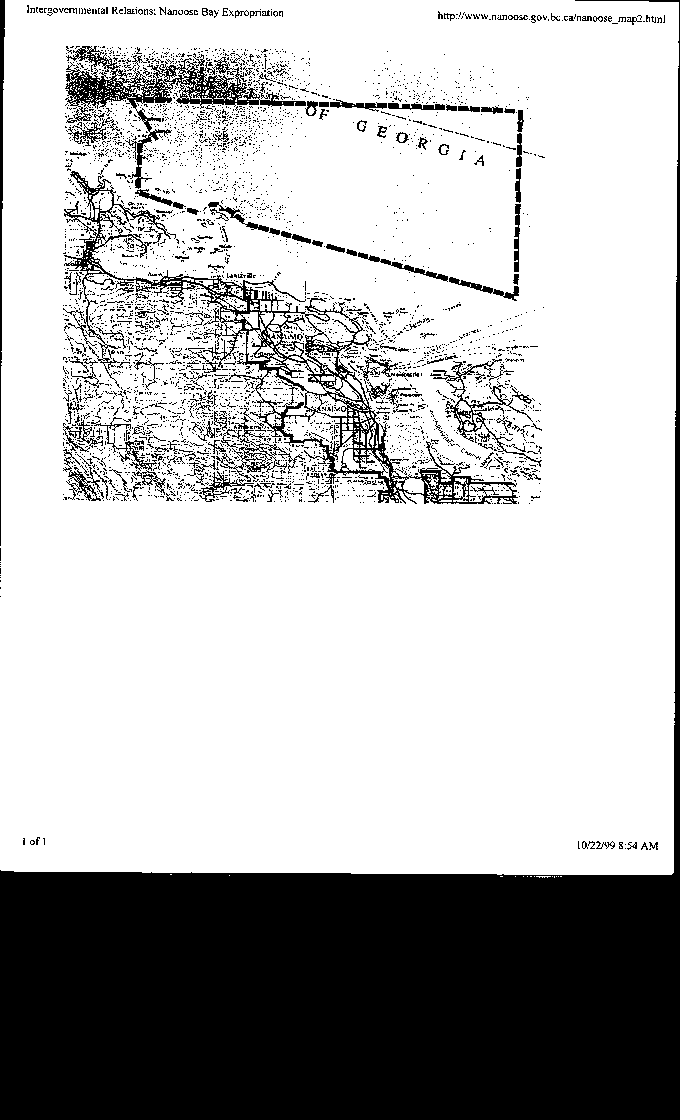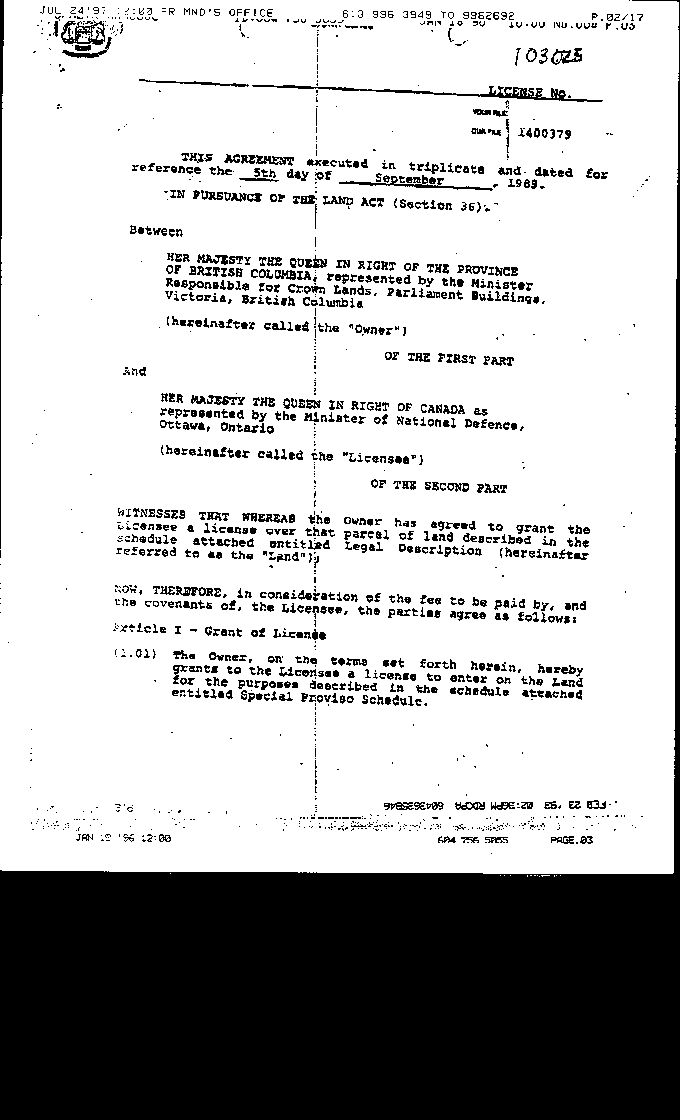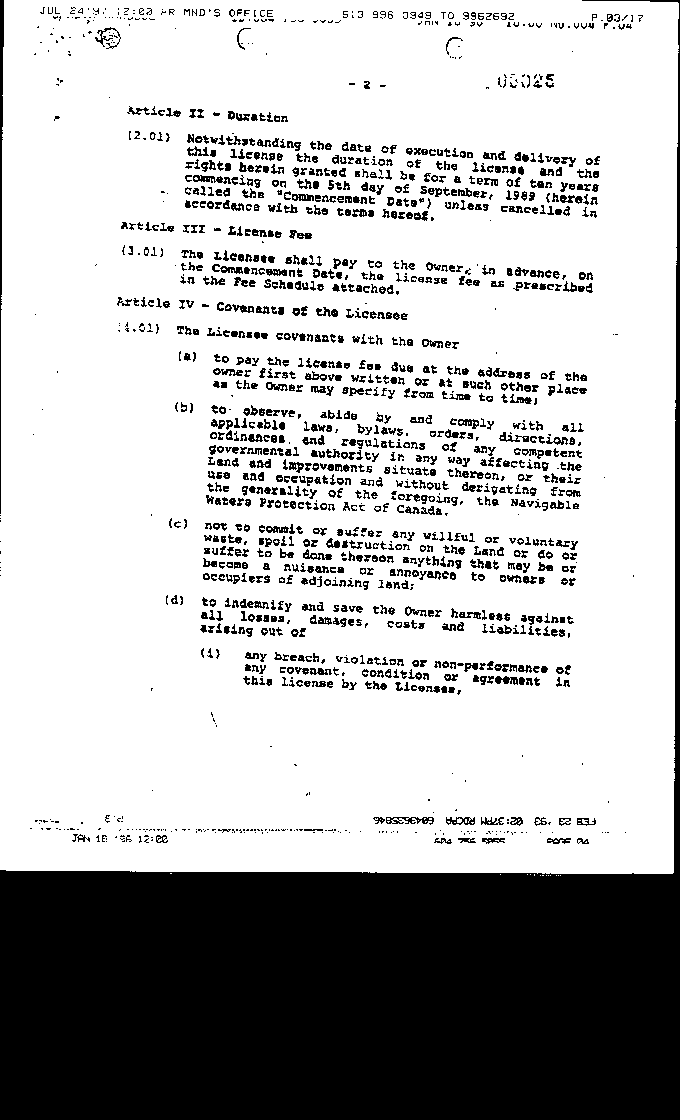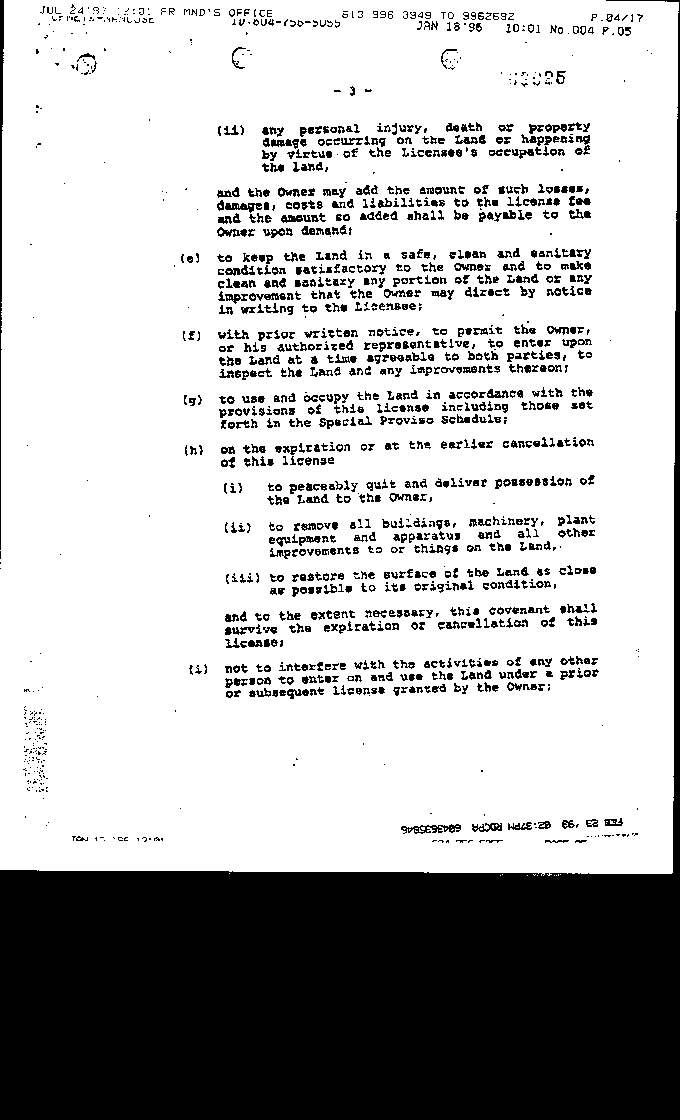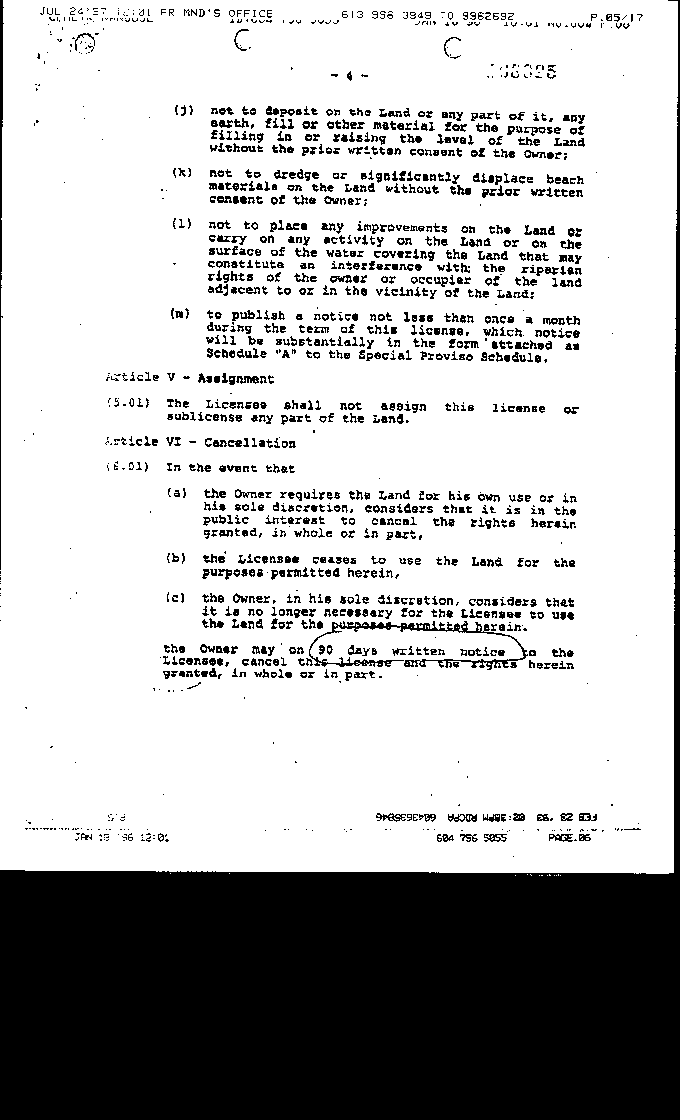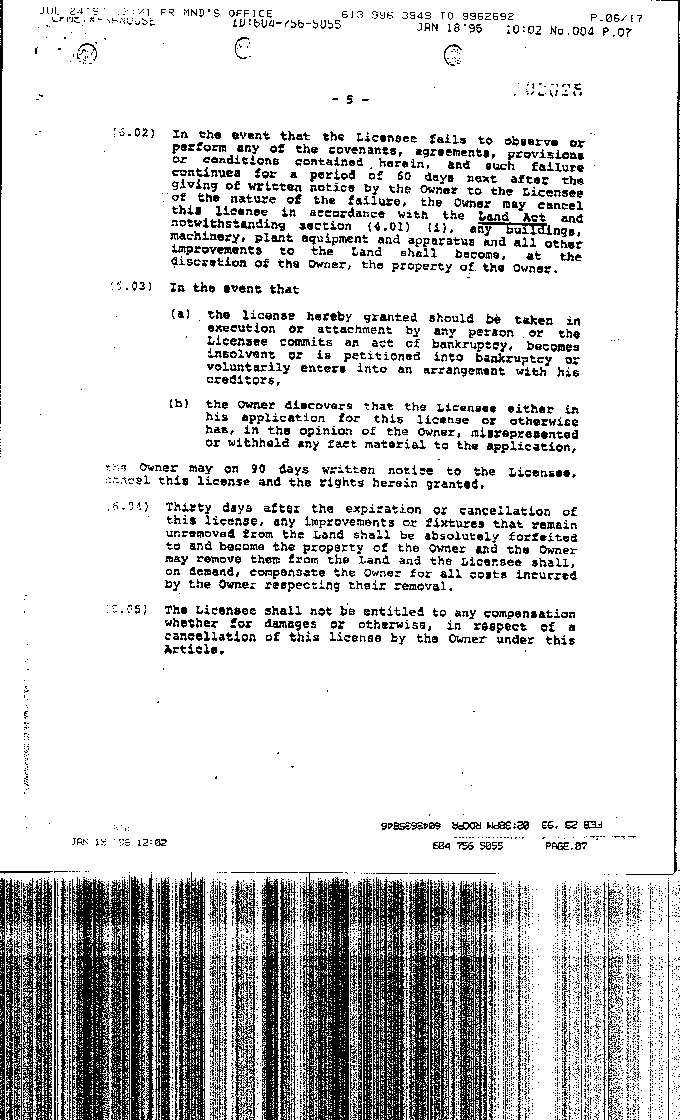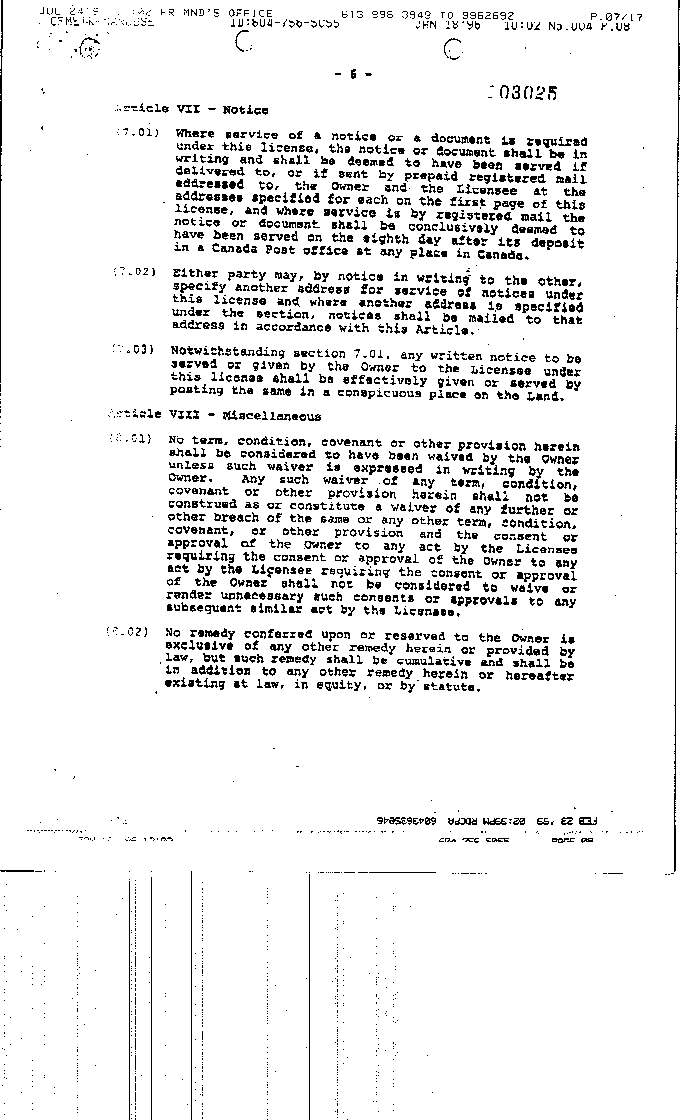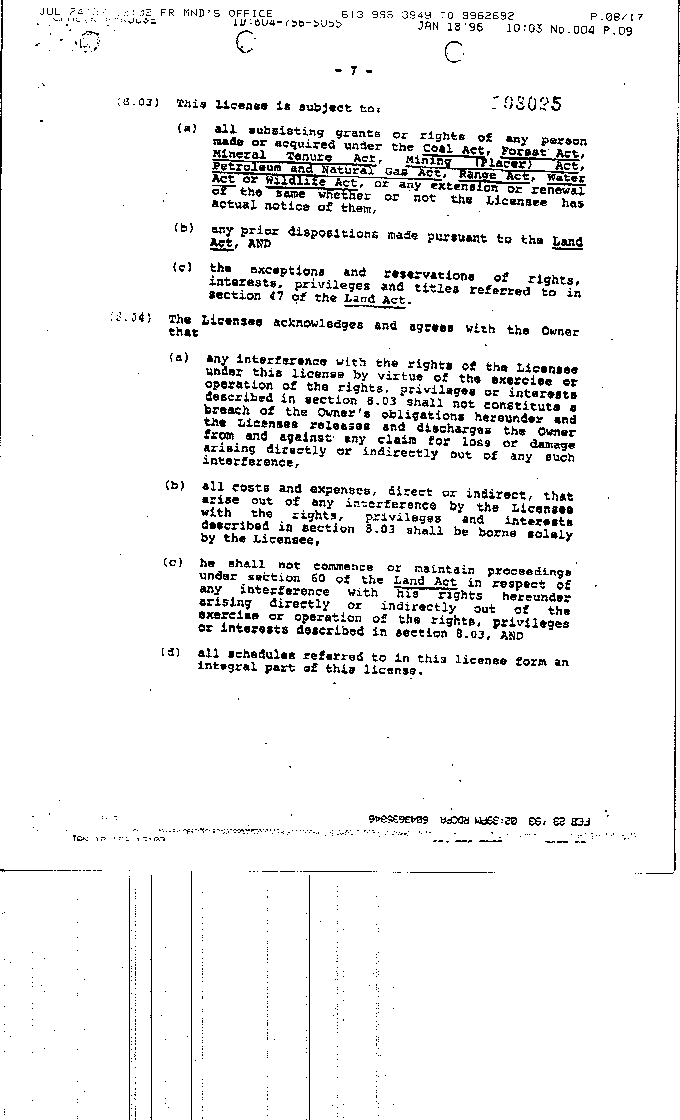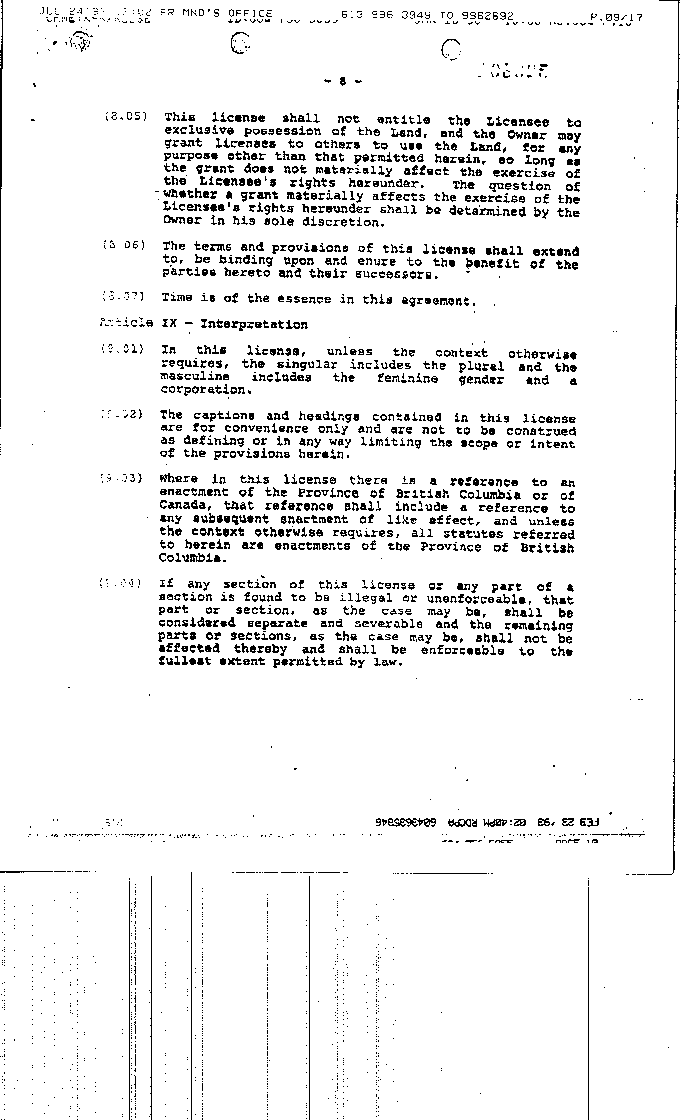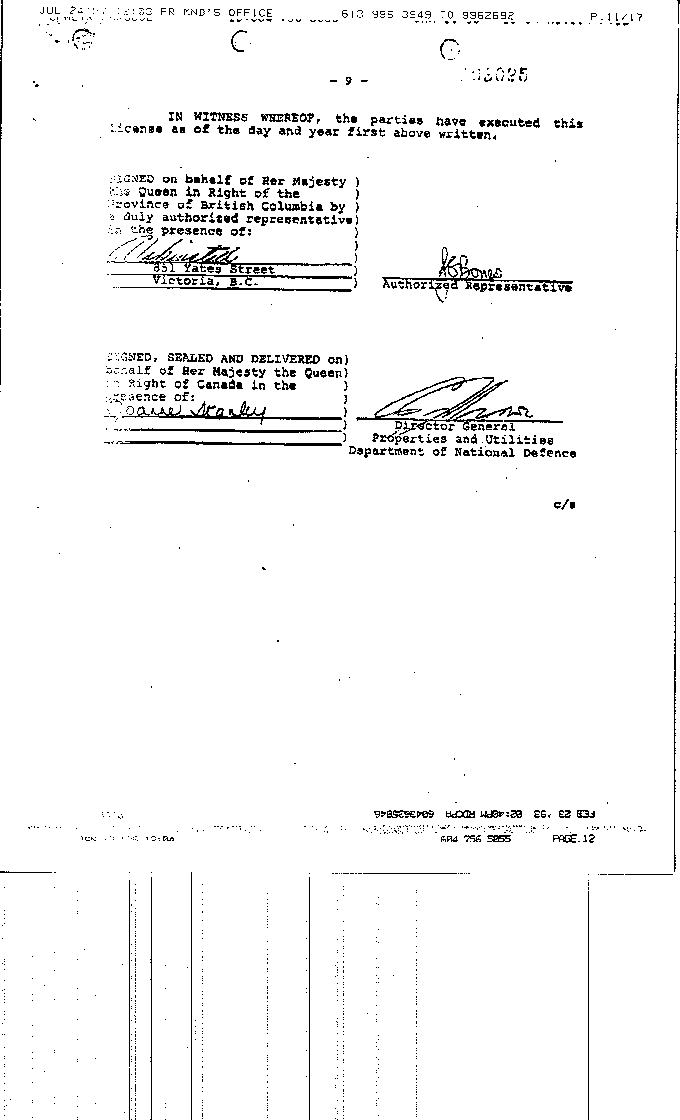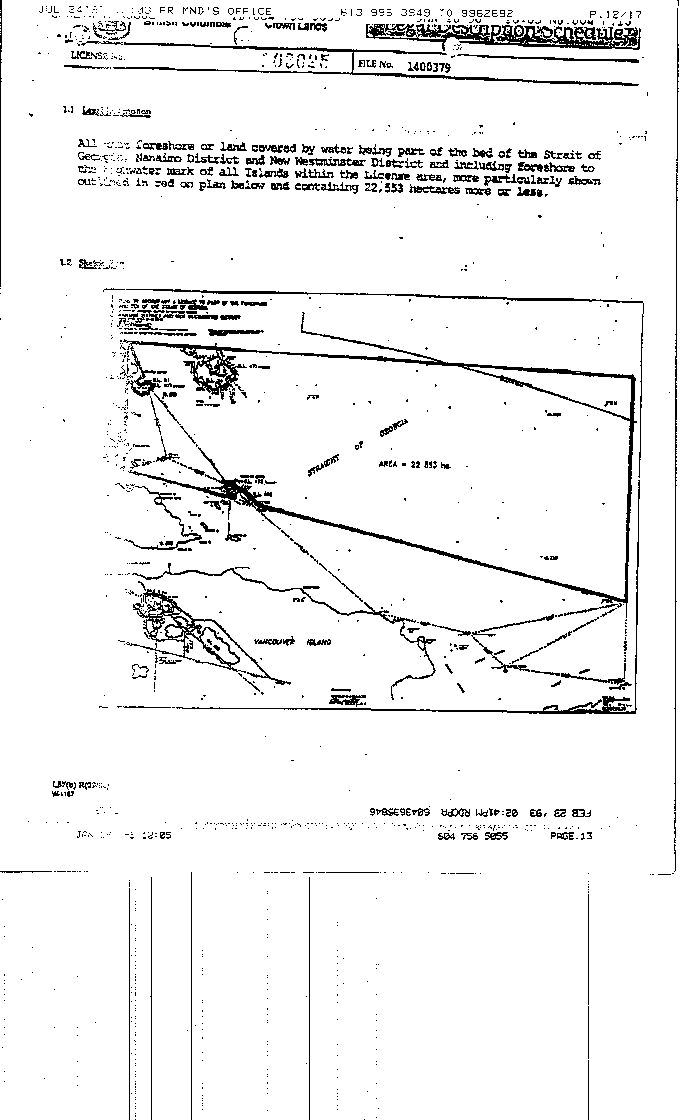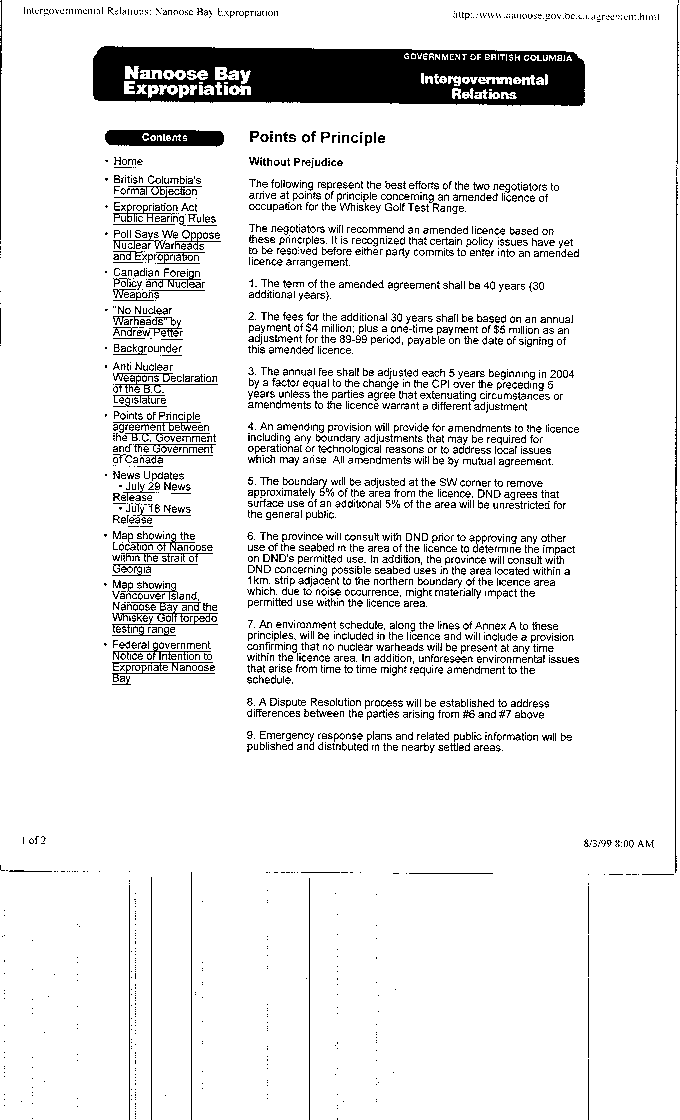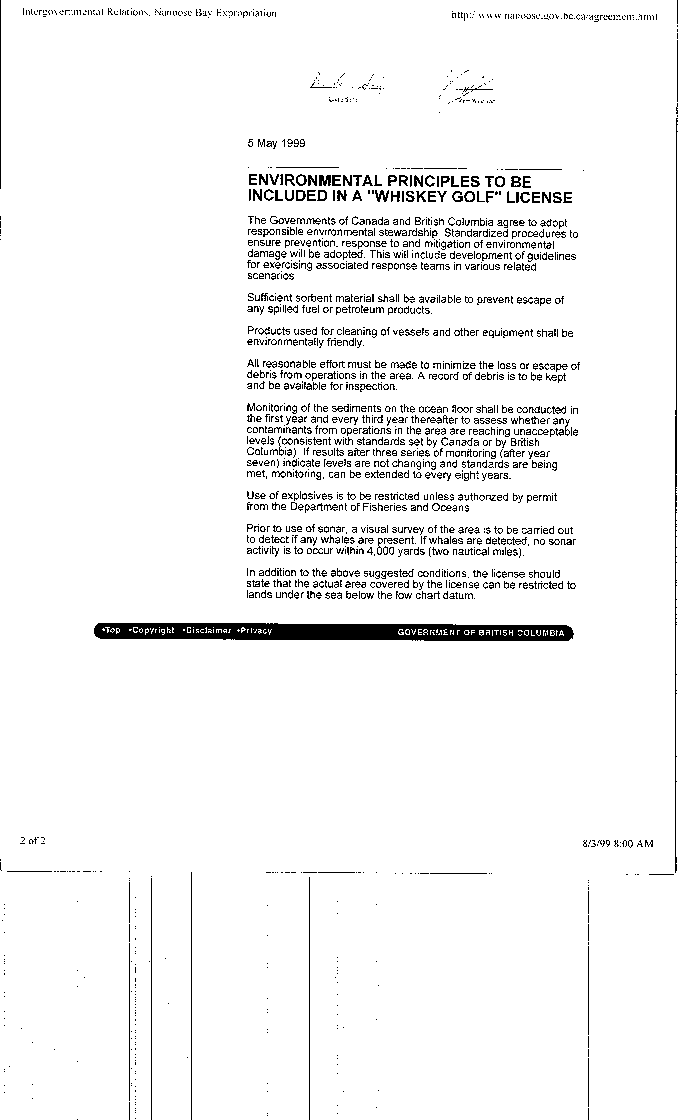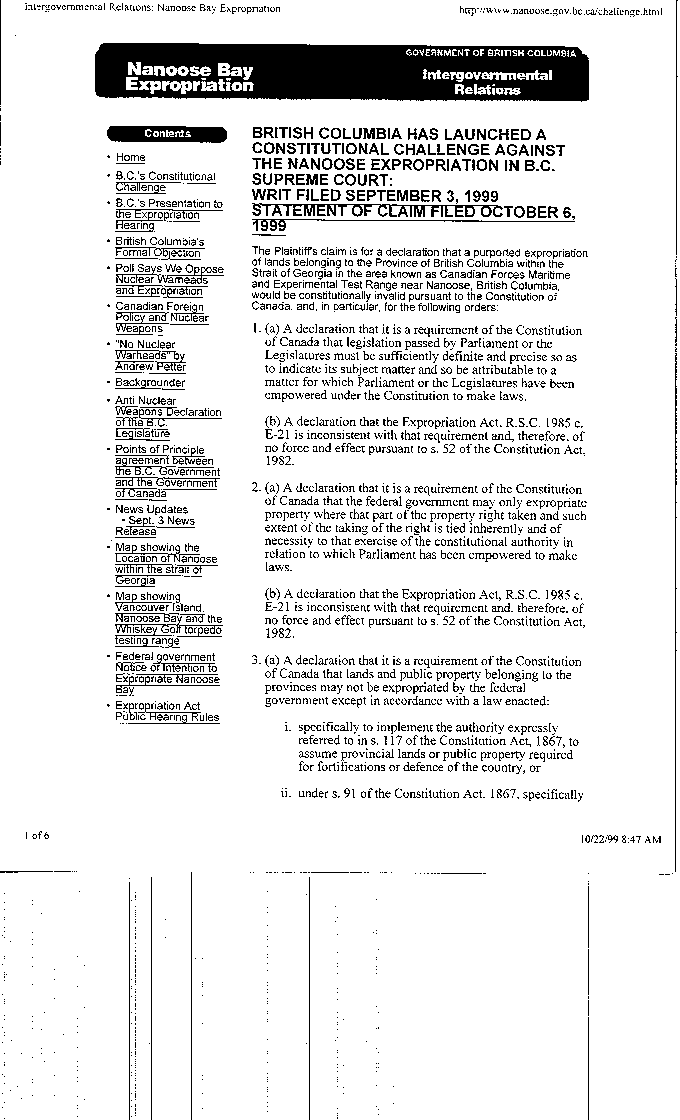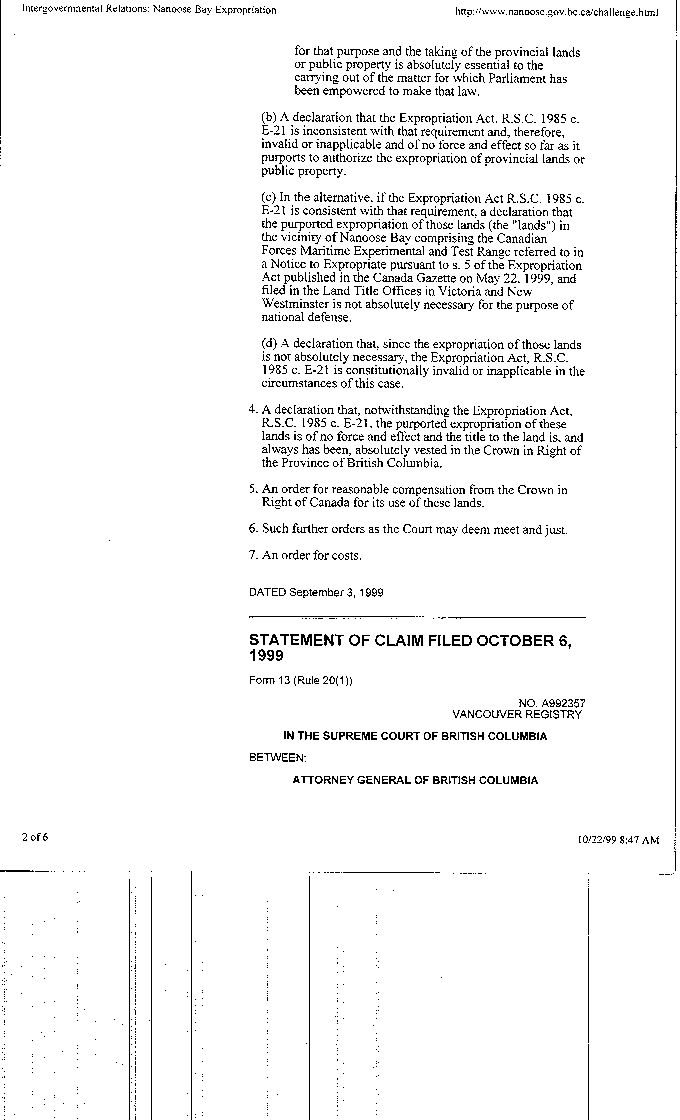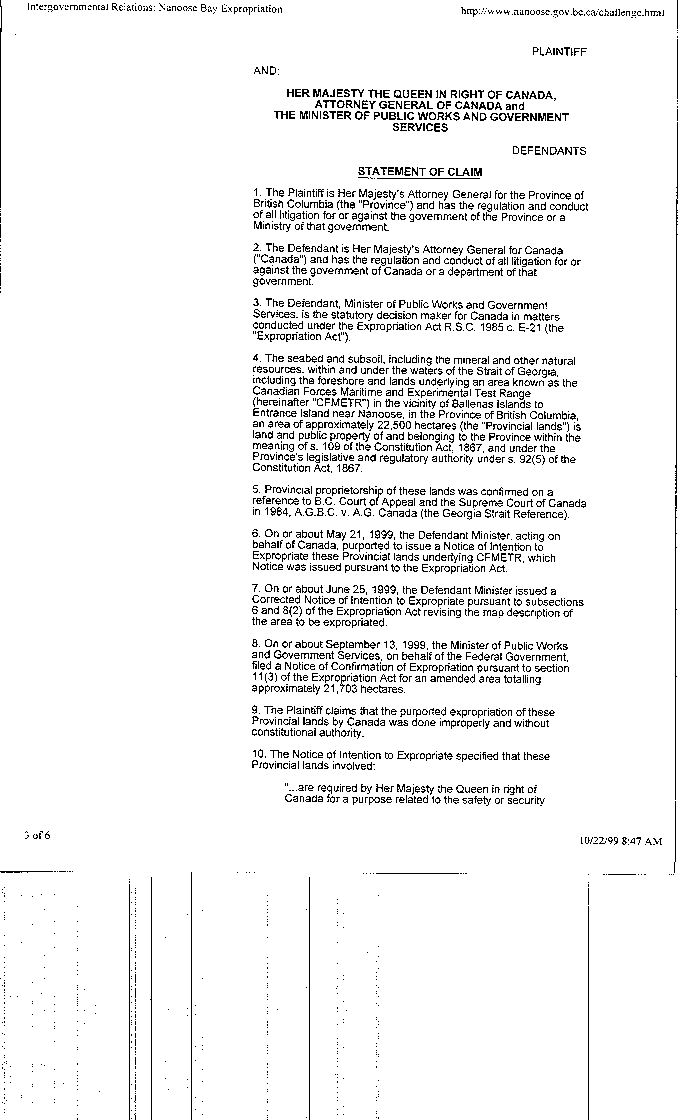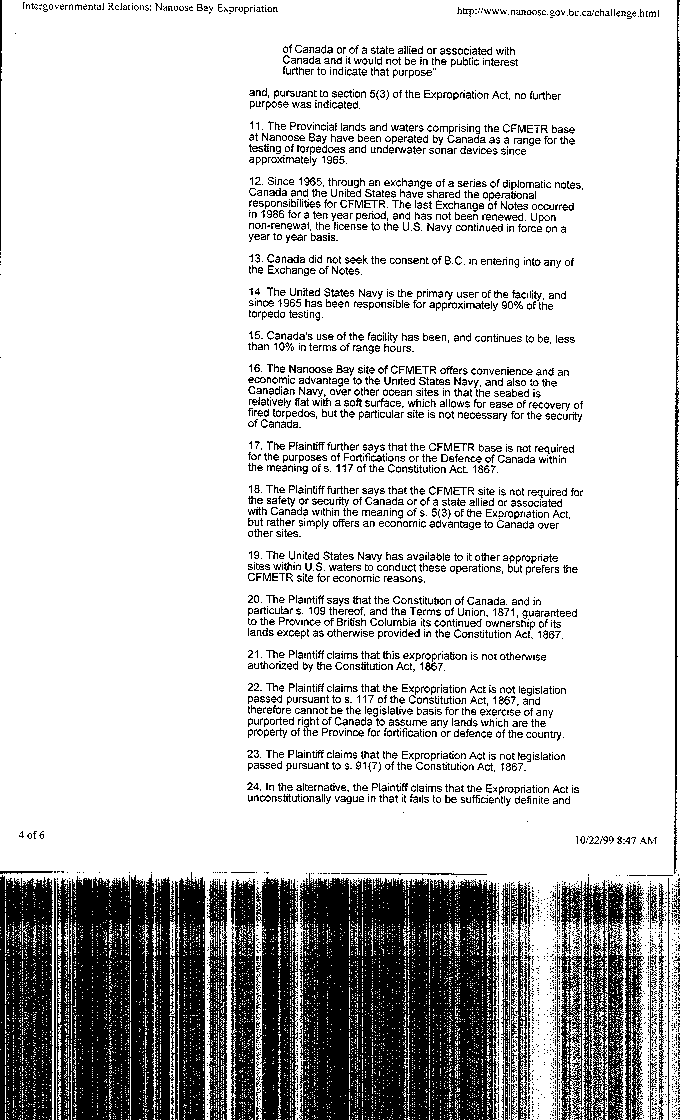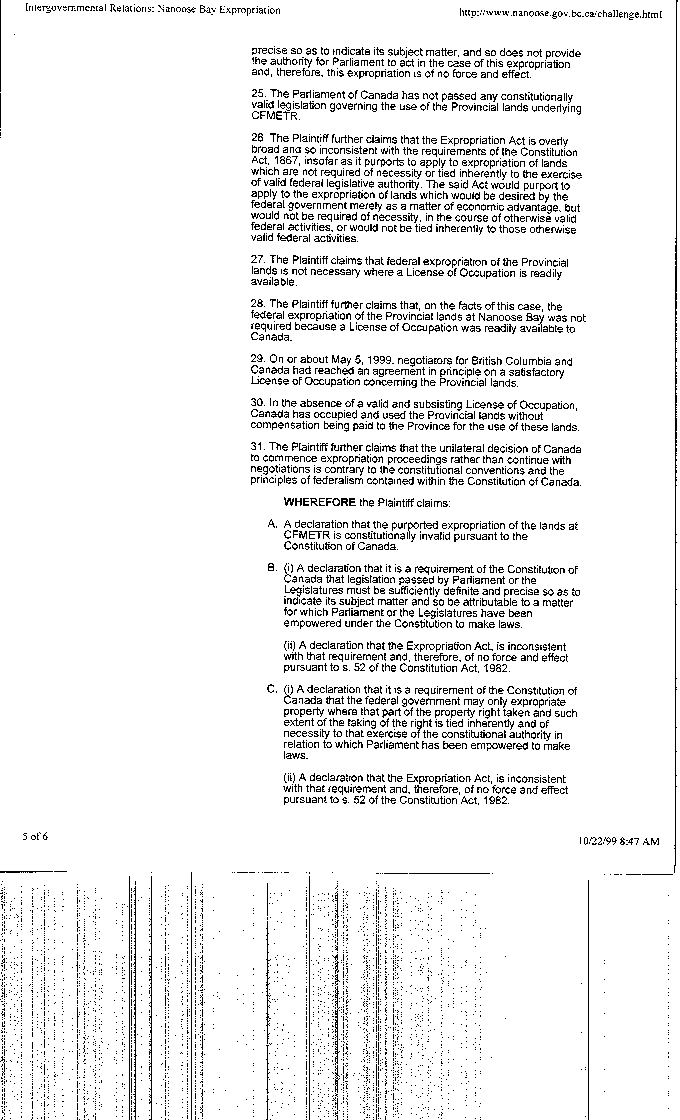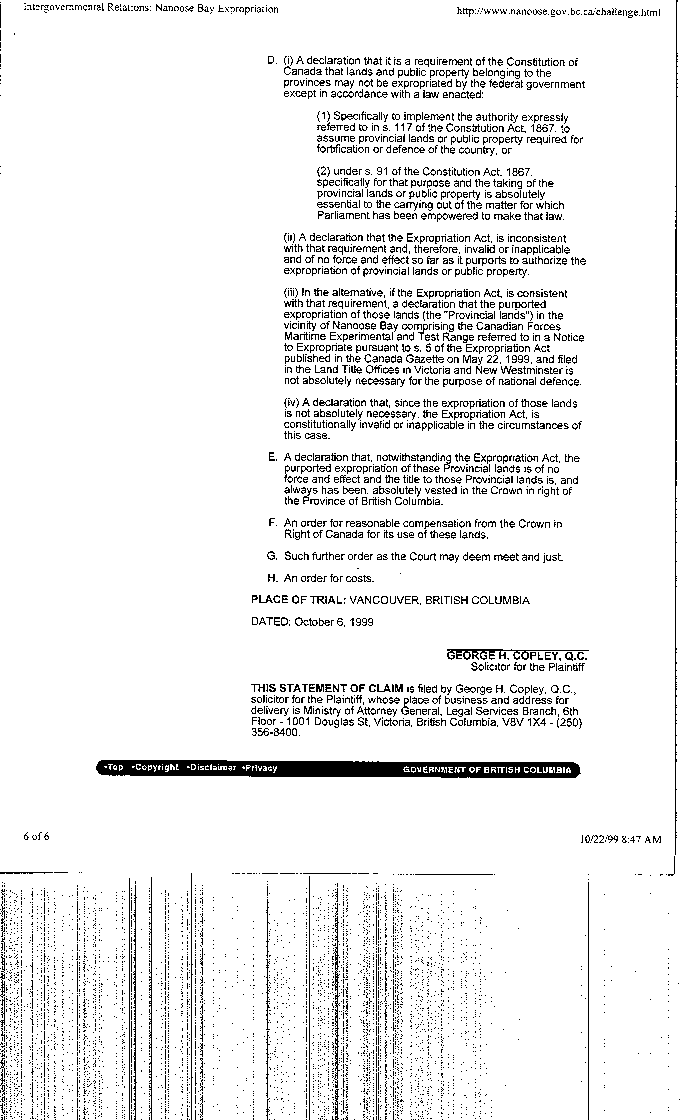|
PRB 99-8E THE NANOOSE BAY
TEST RANGE:
Prepared by: TABLE
OF CONTENTS
THE NANOOSE BAY
TEST RANGE: In 1965, Canada and the United States agreed upon the establishment, operation and maintenance of a torpedo test range at Nanoose Bay in the Strait of Georgia, to be more formally known as the Canadian Forces Maritime Experimental and Test Ranges (CFMETR).(1) The land for the base at Nanoose Bay had been expropriated by the federal government in 1951. The foreshore was transferred to Canada by British Columbia in 1988, for military use over a period of 60 years.(2) In 1984, the Supreme Court of Canada found that several straits on the west coast of British Columbia, including the Strait of Georgia, had been included in the pre-Confederation boundaries of British Columbia. Therefore, the Province of British Columbia still had ownership of the seabed of the Strait, notwithstanding an earlier Supreme Court of Canada decision that the boundaries of British Columbia, with respect to the territorial sea, ended at the low water mark. On 5 September 1989, the federal and provincial governments signed a ten-year "licence of occupation" under the British Columbia Land Act. In May 1997, the British Columbia government gave notice that it would terminate the licence, because it was not satisfied with the progress of Canada-U.S. negotiations on the Pacific Salmon Treaty.(3) Discussions with the federal government followed, but these appear to have collapsed in mid-May 1999. On 14 May 1999, the government of Canada announced that it had begun the process of expropriating the seabed at CFMETR. The Minister of National Defence explained the expropriation as follows:
The Notice of Intention to Expropriate says simply that the lands are required "for a purpose related to the safety and security of Canada or of a state allied or associated with Canada and it would not be in the public interest further to indicate that purpose."(5) British Columbia responded by condemning "the first hostile expropriation of provincial land by Ottawa in recent history."(6) In 1967, the Supreme Court of Canada considered a reference to determine whether the seabed within the three-mile limit of the west coast territorial sea, and the associated mineral resources, were owned by the Province of British Columbia or Canada.(7) Although the case dealt specifically with the British Columbia offshore, it is widely acknowledged to have established the precedent for the ownership of offshore resources on both coasts. The Supreme Court held that Canada had both jurisdiction over and property rights in the territorial sea, from the low-water mark of the province to the territorial boundary recognized by international law.(8) The Supreme Court found that the pre-Confederation colonies had never gained sovereignty over, or property rights in, the territorial sea. The territorial sea had therefore been outside the boundaries of British Columbia at Confederation, and those boundaries had not been extended since. Canada was the sovereign state having the rights over the offshore recognized by international law, such as the 1958 Geneva Convention. In 1984, a more specific question was placed before the Supreme Court in Re Strait of Georgia.(9) Without challenging the general principle set forth in Offshore Minerals, British Columbia claimed that the historical documentation surrounding the establishment of the province proved that certain bodies of water, and the seabed beneath them, had in fact been within the boundaries of the province at Confederation, and were therefore still the property of the province. The question put to the Supreme Court of Canada was:
Dickson J. summarized the issue before the court:
The Supreme Court found that the historical documentation, and in particular the 1866 Imperial Act for the Union of the Colony of Vancouver Island with the Colony of British Columbia had incorporated the straits in question within the boundaries of the colony of British Columbia, and that they therefore continued to be within the boundaries of the Province of British Columbia after Confederation. The western boundary of first the colony and then the Province of British Columbia was the "Pacific Ocean," meaning the open Pacific, "thus making the western boundary of the United Colony the coastline formed by the several islands off the coast of British Columbia, including Vancouver Island."(12) The straits at issue were within the boundaries of British Columbia, and therefore the seabed and subsoil of those straits were the property of the province. The original treaty establishing CFMETR(13) provided that the United States would be responsible for the supply, installation and maintenance of the technical equipment required for the operation of the new torpedo testing range. It also provided that the United States would retain ownership of all removable property it brought into or purchased in Canada and placed on the site, including structures that could be readily dismantled. The agreement was for a ten-year period, but was then to remain in force until it was terminated by mutual agreement or by either party’s giving 12 months’ written notice to the other. Although the agreement continued until terminated, it was renewed by an exchange of notes in 1976(14) because the United States wished to update existing range equipment and to install an advanced underwater acoustic measurement system at Jarvis Inlet. Renewing the treaty at that time allowed the parties to make the necessary minor changes to the annex. In 1986, the treaty was again renewed for ten years, by an exchange of notes, to allow for long-term planning and commitment of resources.(15) In 1996, no renewal took place because of Canada’s requirement for an environmental clause to be added. In March 1998, however, the United States accepted a text proposed by Canada for the incorporation of environmental protocols that would be referenced by the international agreement.(16) Press reports suggest that the value of the equipment involved in the torpedo testing facility is considerable:
In 1989, the federal and provincial government signed a "licence of occupation" under the provincial Land Act.(19) Although the Land Act defines "Crown land" as "land, whether or not it is covered by water," the federal-provincial agreement is clearly based on precedents that involved land, rather than a seabed. For example, it provides for written notice to be given to the licensee by "posting the same in a conspicuous place on the Land." Article 6 of the agreement allows the province to cancel the licence of occupation on 90 days’ written notice, in certain circumstances, which include:
This provincial discretion to cancel is so broad that it is difficult to know how it would be interpreted. The Backgrounder to the press release from the Premier’s office announcing the cancellation of the lease on 23 May 1999(20) refers to the fact that the agreement "provides for cancellation at the sole discretion of the Province of British Columbia when the Province considers that it is no longer necessary for the licensee to use the seabed." Arguably, it is inappropriate for a provincial government to decide unilaterally that the federal government no longer needs a seabed supporting defence structures crucial to an international treaty obligation. The Backgrounder also clearly states that "British Columbia is cancelling the Licence of Occupation for the Nanoose torpedo range in response to the American failure to cooperate with Canadians over West Coast fishing issues." This suggests that the province is taking over the responsibility for defining the "public interest" in matters of fisheries and defence policy. In August 1997, the Government of Canada initiated a court challenge in the Superior Court of British Columbia to prevent an early termination of the agreement with the Government of British Columbia. Canada argued that:
By the spring of 1999, with the natural expiration of the licence of occupation only six months away, it was evident that its cancellation, and the subsequent court case, were increasingly irrelevant to the final outcome of the issue. On 5 May 1999, the negotiators for the two parties signed a "without prejudice" document called Points of Principle,(21) which commenced:
Point 7 provided that "an environmental schedule ... will include a provision confirming that no nuclear warheads will be present at any time within the licence area." The Department of National Defence claims that negotiations reached an impasse by 10 May 1999, after the government of British Columbia introduced "fisheries issues unrelated to the operations of CFMETR."(22) On the other hand, British Columbia’s Minister of Intergovernmental Relations claimed that the negotiations collapsed because the federal government "backed away" from the Points of Principle, and "wouldn’t prohibit nuclear warheads."(23) In any case, on 21 May 1999 the Minister of Public Works and Government Services issued a Notice of Intention to Expropriate on behalf of Canada. On 13 September 1999, after a summer of contentious public hearings on the issue, the same Minister confirmed the expropriation, offering less than $2 million compensation instead of the total of $125 million compensation referred to in the Points of Principle. British Columbia has launched a constitutional challenge against the expropriation.(24) Generally speaking, the federal government can expropriate provincially owned property, provided it does so for a valid federal purpose. Peter Hogg notes that "federal legislative power will extend to bind the Crown in right of a province, and there have been cases in which the federal Parliament has validly expropriated provincial Crown property,"(25) and refers to several cases where this proposition has been upheld. It should be noted, however, that the courts are inclined to place strict limitations upon the federal power of expropriation. Two of the cases cited by Professor Hogg are railway cases from the first quarter of the century. The third, Re Exported Natural Gas Tax, dealt with the taxation of provincial property, rather than its expropriation. The question of the federal expropriating power was raised during argument, however, and the majority of the court held that the federal power to expropriate provincial property extended only to "the property absolutely essential to the Dominion undertaking":
On the other hand, international defence treaties would seem to be at the very core of federal jurisdiction and in Re Strait of Georgia the Supreme Court of Canada took pains to point out that the provincial powers of ownership of the seabed are limited:
Perhaps the only safe conclusion to be drawn with respect to the intended expropriation of the CFMETR seabed is that such action appears both legally justifiable and politically controversial.
(1) See Appendix 1 for the location of the range. (2) "B.C. Ends Seabed Lease for Nanoose Torpedo Range in Response to U.S. Intransigence on Salmon Talks," Backgrounder, press release from the office of the Premier of British Columbia, 23 May 1997. (3) "‘We have taken this step in the public interest because we have been disturbed and frustrated by the unco-operative and unfriendly approach taken by the United States in our efforts to negotiate new terms for the Pacific Salmon Treaty,’ said Premier Glen Clark," press release, see note 2. (4) "Government of Canada Begins Expropriation Process to Retain Seabed Testing Site at Nanoose Bay," Department of National Defence, press release, 14 May 1999. (5) Canada Gazette, Part I, 22 May 1999, 1503. (6)
"Backgrounder," Intergovernmental Relations: Nanoose Bay
Expropriation website, (7) Reference re Offshore Mineral Rights (B.C.), [1967] S.C.R. 792, 65 D.L.R. (2d) 353. (8) In 1967, international law recognized a three mile wide territorial sea. (9) [1984] 1 S.C.R. 388, 8 D.L.R. (4th) 161. (10) See note 9, 8 D.L.R. (4th) 161, at p. 165. (11) See note 9, 8 D.L.R. (4th) 161, at p. 172. (12) See note 9, 8 D.L.R. (4th) 161, at p. 191. (13) Treaty Series 1965 No. 6. (14) Treaty Series 1976 No. 18. (15) Treaty Series 1986 No. 40. (16) This agreement was conveyed by means of a Diplomatic Note from the United States on 13 March 1998. See "Chronology of Events: Canadian Forces Maritime Experimental Test Ranges (CFMETR)," Department of National Defence press release, 14 May 1999. (17) Larry Pynn, "B.C.’s Threat to End Lease Could Cost U.S. Millions," Vancouver Sun, 23 May 1997, p. A1. (18) Ross Howard, "B.C. Cancels Military Lease," The Globe and Mail (Toronto), 23 May 1997, p. A1. (19) See Appendix 2 for the Lease of Occupation. (20) See note 2, above. (21)
Intergovernmental Relations: Nanoose Bay Expropriation website, (22) "Chronology of Events: Canadian Forces Maritime Experimental Test Ranges (CFMETR)," Department of National Defence press release, 14 May 1999. (23) Andrew Petter, "Nanoose Expropriation: An Unprecedented Abuse of Federal Power," Victoria Times Colonist, 25 May 1999, A11. (24) See Appendix 4 for the Statement of Claim. (25) Section 28.5(c), Constitutional Law of Canada (Looseleaf edition). (26) [1982] 1 S.C.R. 1004, at p. 1052-3). (27) See note 9, above, 8 D.L.R.(4th) 161, at 166. |
